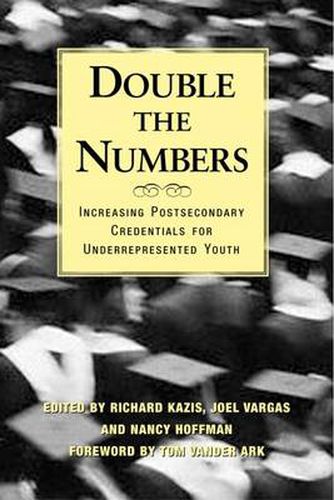Readings Newsletter
Become a Readings Member to make your shopping experience even easier.
Sign in or sign up for free!
You’re not far away from qualifying for FREE standard shipping within Australia
You’ve qualified for FREE standard shipping within Australia
The cart is loading…






Double the Numbers explores policies that are likely to serve as building blocks in any next phase of education reform that tackles the dual problems of high school completion and postsecondary access and success.
Only 25 percent of the U.S. high school students complete any college degree. Among African American youth, only 18 percent earn a baccalaureate by age twenty-nine. For Hispanic Americans, the figure is a mere 10 percent.
The United States urgently needs to address this problem. For reasons of intellectual and professional opportunity, economic efficiency, and social equity, the nation must do a better job of preparing young people not only to enter college, but also to earn credentials that are key to professional and economic success.
Double the Numbers highlights emerging strategies–at state, district, and school levels–for improving postsecondary outcomes. High schools pose special challenges in this regard: how to motivate older adolescents in school settings; how to overcome the rigidities of high school schedules and routines; how to prepare students for smooth transitions to postsecondary learning and success. This book explores policies that are likely to serve as building blocks in any next phase of education reform that tackles the dual problems of high school completion and postsecondary access and success.
The contributions from many of the leading figures in education reform, such as Kati Haycock, Robert Schwartz, and Marc Tucker, address these issues from a number of distinct perspectives. The authors propose changes in the designs fo high schools and colleges–innovations that could overcome the discontinuities, perverse incentives, and inflexibilities of existing educational institutions. They focus on state policy because to double the number of students attaining postsecondary credentials within a decade will require aggressive innovation by states. Finally, they consider how oppoortunities and outcomes vary by race, ethnicity, and gender, and they look at the implications of these variations for policy and practice.
$9.00 standard shipping within Australia
FREE standard shipping within Australia for orders over $100.00
Express & International shipping calculated at checkout
Double the Numbers explores policies that are likely to serve as building blocks in any next phase of education reform that tackles the dual problems of high school completion and postsecondary access and success.
Only 25 percent of the U.S. high school students complete any college degree. Among African American youth, only 18 percent earn a baccalaureate by age twenty-nine. For Hispanic Americans, the figure is a mere 10 percent.
The United States urgently needs to address this problem. For reasons of intellectual and professional opportunity, economic efficiency, and social equity, the nation must do a better job of preparing young people not only to enter college, but also to earn credentials that are key to professional and economic success.
Double the Numbers highlights emerging strategies–at state, district, and school levels–for improving postsecondary outcomes. High schools pose special challenges in this regard: how to motivate older adolescents in school settings; how to overcome the rigidities of high school schedules and routines; how to prepare students for smooth transitions to postsecondary learning and success. This book explores policies that are likely to serve as building blocks in any next phase of education reform that tackles the dual problems of high school completion and postsecondary access and success.
The contributions from many of the leading figures in education reform, such as Kati Haycock, Robert Schwartz, and Marc Tucker, address these issues from a number of distinct perspectives. The authors propose changes in the designs fo high schools and colleges–innovations that could overcome the discontinuities, perverse incentives, and inflexibilities of existing educational institutions. They focus on state policy because to double the number of students attaining postsecondary credentials within a decade will require aggressive innovation by states. Finally, they consider how oppoortunities and outcomes vary by race, ethnicity, and gender, and they look at the implications of these variations for policy and practice.